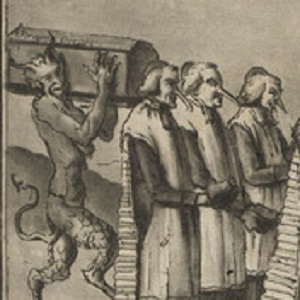Religion

Letter to Panduranga Joshi Kulkarni
Although the self-immolation of Hindu widows was less common in western India than in Bengal, this letter confirms its occurrence in Maratha-ruled areas during the 1700s.

Journal of Jan van Riebeeck
Krotoa, called Eva by the Dutch, is the first Khoikhoi woman to appear in the European records of the early settlement at the Cape as an individual personality and active participant in cultural and economic exchange.

Patience Monsignor Your Turn Will Come
Cartoons attacked the refractory clergy. Here, fat, overfed, and underworked clergy are squeezed down to an appropriate size. As elsewhere, visual images mocked the clergy by depicting them as subject to the threats and physical attacks of others.

Refractory (Clergy) Going to the Promised Land
Many refractory clergy left France to join other detractors, as this print shows, or wishfully encourages. However, this is an ambiguous image, which leaves open the possibility that rather than joining foreign monarchies, the clergy are crossing the river leading to Hell.

Procession of Refractory Clergy
Of particular interest in this caricature of refractory clergy here are the long noses, traditionally used to caricature Jews, that suggest the refractory clergy were not of the people. This image shows resistant clergy marching in their last procession.

Boys' Initiation Mask (keweke)
This mask worn by boys during initiation rituals in Papua New Guinea is made of painted bark cloth and canvas stretched over a cane frame. The long fiber fringe adds movement to the mask, which is worn during dances and other secret rituals that that comprise boyhood initiation rites.

Gope, Ancestor or Spirit Boards
The object in the photograph is a gope, or spirit board (also called kwoi or hohao). This example is from Papua New Guinea near the Wapo Creek on the Gulf of Papua.

Writing a Letter to Santa
Whether known as Saint Nicholas, Sinterklaas, Father Christmas, Kris Kringle, Babbo Natale, Christkind, Père Noël, Santa Claus ("Santa") or by many other names, this legendary gift-giver in European folklore and hagiography is well known around the world.

Massacre of the Priests
This image, also reproduced from the newspaper R*volutions de Paris, shows crowds massacring refractory clergy and prisoners.

Massacre of the Prisoners of St. Germain Abbey
In one of the most widely reported incidents of the September massacres, a "jury" of twelve "commissioners" was formed spontaneously in the Saint–Germain Abbey to judge the refractory clergy held there as prisoners.